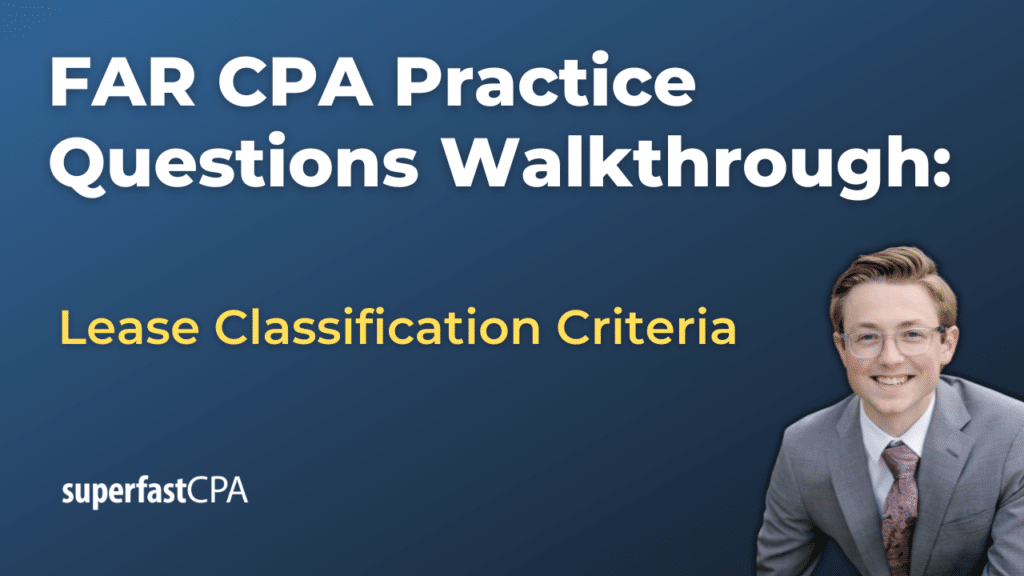In this video, we walk through 5 FAR practice questions about the lease classification criteria. These questions are from FAR content area 3 on the AICPA CPA exam blueprints: Select Transactions.
The best way to use this video is to pause each time we get to a new question in the video, and then make your own attempt at the question before watching us go through it.
Also be sure to watch one of our free webinars on the 6 “key ingredients” to an extremely effective & efficient CPA study process here…
Understanding the Lease Classification Criteria
Leases play a significant role in financial reporting, as they often represent long-term commitments that can impact a company’s balance sheet and financial performance. The classification of a lease as either a finance lease or an operating lease determines how it is recorded and presented in the lessee’s financial statements. This guide explains the five key criteria for classifying a lease as a finance lease, or the lack of those criteria leading to an operating lease.
What is a Finance Lease?
A finance lease reflects a transaction in which the lessee essentially gains control of the underlying asset, similar to a purchase financed over time. When any of the following criteria are met, a lease is classified as a finance lease. If none of these criteria are met, it is classified as an operating lease.
The Five Key Criteria for Finance Lease Classification
- Ownership Transfer
If ownership of the underlying asset transfers to the lessee by the end of the lease term, the lease is classified as a finance lease. This criterion is straightforward, as the transfer of ownership directly aligns the lease with a purchase agreement. - Bargain Purchase Option
A lease is classified as a finance lease if it includes a purchase option that is reasonably certain to be exercised. This is often referred to as a bargain purchase option, where the lessee can purchase the asset at a price significantly below its expected fair value, creating a strong economic incentive to exercise the option. - Lease Term (Majority of Useful Life)
If the lease term covers 75% or more of the asset’s economic life, the lease is considered a finance lease. This criterion highlights that the lessee is utilizing the majority of the asset’s useful life, effectively gaining control over it for most of its value-generating period.- Example: A 9-year lease for an asset with a 10-year economic life would meet this criterion, as 9/10 = 90%, which exceeds the 75% threshold.
- Present Value of Lease Payments
A lease qualifies as a finance lease if the present value of the minimum lease payments equals or exceeds 90% of the fair value of the underlying asset. This criterion indicates that the lessee is paying for nearly the full value of the asset over the lease term, akin to financing its purchase.- Example: If the present value of lease payments is $180,000, and the fair value of the asset is $200,000, then $180,000 / $200,000 = 90%, meeting this criterion.
- Specialized Use / No Alternative Use
If the underlying asset is so specialized that it has no alternative use to the lessor at the end of the lease term, the lease is classified as a finance lease. This typically applies to custom-built assets or those uniquely designed for the lessee’s operations.- Example: A robotic arm designed exclusively for the lessee’s production line, which cannot be used by other companies without significant modifications, meets this criterion.
Why Lease Classification Matters
The classification of a lease determines its impact on financial statements:
- Finance Lease:
- The lessee records a right-of-use (ROU) asset and a corresponding lease liability on the balance sheet.
- The expense is split between interest expense on the lease liability and amortization of the ROU asset.
- Operating Lease:
- The lessee records the ROU asset and lease liability, but the expense is recognized as a single lease expense on a straight-line basis over the lease term.
Proper classification ensures that users of financial statements have an accurate view of a company’s financial obligations and asset control.
Conclusion
Understanding the five criteria for finance lease classification is essential for accurate financial reporting and compliance with accounting standards. Each criterion evaluates whether the lessee effectively controls the underlying asset and benefits from its use. By mastering these concepts, companies can ensure their lease agreements are appropriately reflected in their financial statements.













